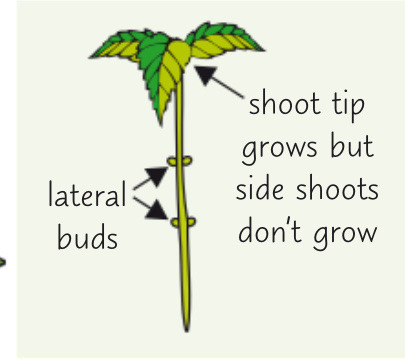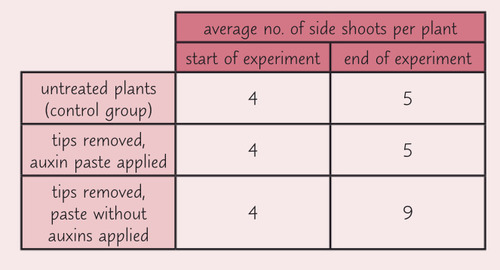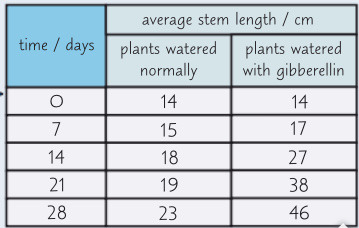Biology - 16.1 plant hormones and growth in plants
0.0(0)
Card Sorting
1/17
Earn XP
Description and Tags
Study Analytics
Name | Mastery | Learn | Test | Matching | Spaced |
|---|
No study sessions yet.
18 Terms
1
New cards
How have plants evolved to form a system of hormones
Chemicals that are produced in 1 region of the plant are transported both through the tissues and from cell to cell and have an effect in another part of the plant
2
New cards
What are some important plant hormones
Auxins
Gibberellin
Ethene
ABA (abscisic acid)
Gibberellin
Ethene
ABA (abscisic acid)
3
New cards
What is the role of the plant hormones
- auxins - control cell elongation, prevent leaf fall (abscission), maintain apical dominance, involved in tropisms, stimulate the release of ethene, involved in fruit ripening
- gibberellin - cause stem elongation, trigger the mobilisation of food stores in a seed at germination, stimulate pollen tube growth in fertilisation
- ethene - causes fruit ripening, promotes abscission in deciduous trees
- ABA (abscisic acid) - maintains dormancy of seeds and buds, stimulates cold protective responses, for example, antifreeze production, stimulates stomatal closing
- gibberellin - cause stem elongation, trigger the mobilisation of food stores in a seed at germination, stimulate pollen tube growth in fertilisation
- ethene - causes fruit ripening, promotes abscission in deciduous trees
- ABA (abscisic acid) - maintains dormancy of seeds and buds, stimulates cold protective responses, for example, antifreeze production, stimulates stomatal closing
4
New cards
What is the apical bud
The shoot tip at the top of a flowering plant
5
New cards
What is apical dominance
When auxins stimulate the growth of the apical bud and inhibit the growth of side shoots from lateral buds
Apical buds are dominant over the lateral buds
Apical buds are dominant over the lateral buds

6
New cards
What does apical dominance prevent
Side shoots from growing - this saves energy and prevents side shoots from the same plant competing with the shoot tip for light
7
New cards
What does apical dominance allows a plant to do
In an area where there are loads of other plants, it allows the plant to grow tall very fast to reach the sunlight
8
New cards
What happens when you remove the apical bud
The plant wont produce auxins, so the side shoots will start growing by cell division and cell elongation
9
New cards
What happens when you replace the tip of a plant
The source of auxins, side shoot development is inhibited meaning apical dominance is controlled by auxin
10
New cards
What happens to auxin concentration as you move down the plant
Become less concentrated as they move away from apical bud. If plant grows very tall, the bottom of the plant will have a low auxin concentration so side shoots will start to grow near the bottom.
Promote root growth as well
Promote root growth as well

11
New cards
How can you investigate the role of auxins on apical dominance
1) Plant 30 plants (e.g. pea plants) that are a similar age, height and weight in pots.
2)Count and record the number of side shoots growing from the main stem of each plant.
3) For 10 plants, remove the tip of the shoot and apply a paste containing auxins to the top of the stem.
4) For another 10 plants, remove the tip of the shoot and apply a paste without auxins to the top of the stem.
5) Leave the final 10 plants as they are - these are your untreated controls. These are needed for comparison so that you know the effect you see is likely to be due to the hormone and not any other factor.
6) Let each group grow for six days. You need to keep all the plants in the same conditions - the same light intensity, water, etc. This makes sure any variables that may affect your results are controlled,
which makes your experiment valid.
7) After six days, count the number of side shoots growing from the main stem of each of your plants.
8)The results in the table show that removing the tips of shoots caused extra side shoots to grow, but removing tips and applying auxins prevented extra side shoots from growing.
9) The results suggest auxins inhibit the growth of side shoots -
- suggesting that auxins are involved in apical dominance.
2)Count and record the number of side shoots growing from the main stem of each plant.
3) For 10 plants, remove the tip of the shoot and apply a paste containing auxins to the top of the stem.
4) For another 10 plants, remove the tip of the shoot and apply a paste without auxins to the top of the stem.
5) Leave the final 10 plants as they are - these are your untreated controls. These are needed for comparison so that you know the effect you see is likely to be due to the hormone and not any other factor.
6) Let each group grow for six days. You need to keep all the plants in the same conditions - the same light intensity, water, etc. This makes sure any variables that may affect your results are controlled,
which makes your experiment valid.
7) After six days, count the number of side shoots growing from the main stem of each of your plants.
8)The results in the table show that removing the tips of shoots caused extra side shoots to grow, but removing tips and applying auxins prevented extra side shoots from growing.
9) The results suggest auxins inhibit the growth of side shoots -
- suggesting that auxins are involved in apical dominance.

12
New cards
What are gibberellins?
Produced in young leaves and in seeds. They stimulate seed germination, stem elongation, side shoot formation and flowering
13
New cards
What do gibberellins do?
Stimulate the stems of plants to grow by stem elongation - helps plant grow very tall
14
New cards
what do gibberellins stimulate
seed germination, by triggering the breakdown of starch into glucose in the seed. the plant embryo in the seed can then use the glucose to begin respiring and release the energy it needs to grow
15
New cards
How can you investigate the role of gibberellins in stem elongation
1) Plant 40 plants (e.g. dwarf pea plants) that are a similar age, height and mass in pots.
2)Leave 20 plants as they are to grow, watering them all in the same way and keeping
them all in the same conditions - these are your controls.
3) Leave the other 20 plants to grow in the same conditions, except water them with a dilute solution of gibberellin (e.g. 100 mg dm-* gibberellin).
4) Let the plants grow for about 28 days and measure the lengths of all the stems once each week.
5) You might get results a bit like these:
6) The results in the table show that stems grow more when watered with a dilute solution of gibberellin.
7)The results suggest gibberellin stimulates stem elongation.
8) You might have to calculate the rate of growth of the plants in your exam, e.g:
In 28 days the plants watered normally grew an average of 9 cm (23 cm - 14 cm), so they grew at an average rate of 9 ÷ 28 = 0.32 cm/day or 0.32 cm day-1. In 28 days the plants watered with gibberellin grew an average of 32 cm (46 cm - 14 cm), so they grew at an average rate of 32 ÷ 28 = 1.14 cm day-1.
2)Leave 20 plants as they are to grow, watering them all in the same way and keeping
them all in the same conditions - these are your controls.
3) Leave the other 20 plants to grow in the same conditions, except water them with a dilute solution of gibberellin (e.g. 100 mg dm-* gibberellin).
4) Let the plants grow for about 28 days and measure the lengths of all the stems once each week.
5) You might get results a bit like these:
6) The results in the table show that stems grow more when watered with a dilute solution of gibberellin.
7)The results suggest gibberellin stimulates stem elongation.
8) You might have to calculate the rate of growth of the plants in your exam, e.g:
In 28 days the plants watered normally grew an average of 9 cm (23 cm - 14 cm), so they grew at an average rate of 9 ÷ 28 = 0.32 cm/day or 0.32 cm day-1. In 28 days the plants watered with gibberellin grew an average of 32 cm (46 cm - 14 cm), so they grew at an average rate of 32 ÷ 28 = 1.14 cm day-1.

16
New cards
what are gibberellins inhibited by
abscisic acid
17
New cards
why are auxins and gibberellins often called synergistic
work together to have a big effect - work together to help plant grow very tall
18
New cards
why are auxins and gibberellins often called antagonistic
they oppose each other's actions - gibberellins stimulate the growth of side shoots but auxins inhibit the growth of side shoots